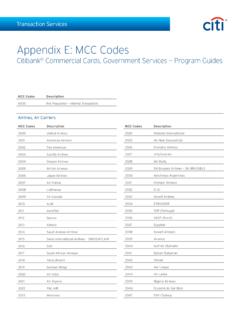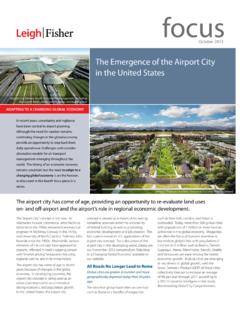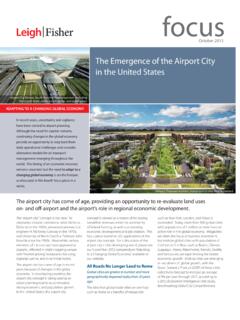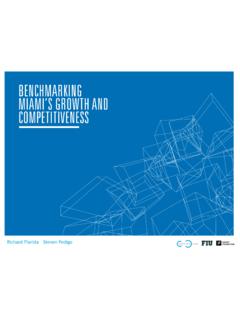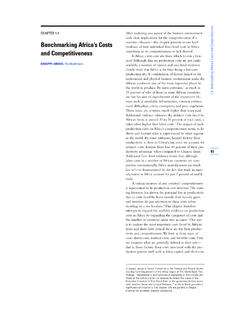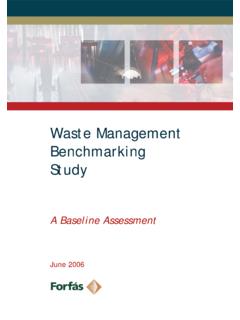Transcription of Benchmarking global city competitiveness - citigroup.com
1 Hot spotsBenchmarking global city competitivenessCommissioned byA report from the Economist Intelligence Unit The Economist Intelligence Unit Limited 20121 Hot spotsBenchmarking global city competitivenessContentsPreface 2 Executive summary 3 Introduction: Striving for competitiveness 8 Finding a competitive advantage 9 Case study: Singapore Asia s most competitive city 10 Rebalancing West and East: Legacy versus growth 11 Case study: Wipro From East to West to East 14 Beyond the megacities: Tomorrow s new power brokers? 15 Case study: Dell s city selection criteria 17 Talent, jobs and quality of life 18 Case study: New York s talent as a competitive edge 20 city size, density and competitive performance 21 Conclusion: Leapfrogging ahead? 23 Appendix 1: Index scores by category 25 Appendix 2: Index scores by region 27 Appendix 3: Full methodology 29 The Economist Intelligence Unit Limited 20122 Hot spotsBenchmarking global city competitivenessHot spots is an Economist Intelligence Unit (EIU) research programme, commissioned by citigroup , which ranks the competitiveness of 120 of the world s major cities.
2 The EIU bears sole responsibility for the content of this report. The EIU s editorial team built the global city competitiveness Index, conducted the analysis and wrote the report. The findings and views expressed in this report do not necessarily reflect the views of the research drew on two main initiatives: A unique Index that compares 120 of the world s major urban agglomerations across eight distinct categories of competitiveness and 31 individual indicators. These cities collectively represent about 29% of the global economy, with a combined GDP of US$ A detailed note on definitions and methodology is provided in the appendix. We conducted in-depth interviews with ten city experts, mayors and corporate executives, to get their insights on city competitiveness .
3 The Index was devised and constructed by an EIU research team led by Manoj Vohra. The author of the report was James Watson and the editor was Sudhir Vadaketh. Sarah Fister Gale and Premila Nazareth assisted with further interviews. Our sincere thanks go to the following interviewees (listed alphabetically by organisation) for their time and insights: Dane Parker, vice president, global facilities, real estate and environmental health and safety, Dell Kevin Stolarick, research director, Martin Prosperity Institute Jaana Remes, senior fellow, McKinsey global Institute Michael Bloomberg, mayor, New York Javier Sanchez-Reaza, economist and urban specialist, OECD Lamia Kamal-Chaoui, head, urban development programme, OECD Johannes Schmidt, CEO, project and structured finance, Infrastructure & Cities and Industry, Siemens Khoo Teng Chye, executive director, Singapore s Centre for Liveable Cities Todd Overmyer, global head of retail, Triumph Hariprasad Hegde, global head of operations.
4 WiproJanuary 2012 Preface The Economist Intelligence Unit Limited 20123 Hot spotsBenchmarking global city competitivenessExecutive summaryWell over half of the world s population now lives in cities, generating more than 80% of global GDP. Already, global business is beginning to plan strategy from a city , rather than a country, perspective. Given the rapid growth and development of many cities, particularly in emerging markets such as China and India, competition between them for business, investment and talent will only get fiercer. Size alone does not determine a city s growth potential. While some megacities, such as New York and Tokyo, are immensely influential, there are smaller ones, such as Hong Kong and Singapore, which have established themselves as globally competitive centres in recent years.
5 Meanwhile, emerging market cities such as Ahmedabad and Tianjin are witnessing double-digit economic growth and have the potential to grow even , however, is a holistic concept. While economic size and growth are important and necessary, several other factors determine a city s overall competitiveness , including its business and regulatory environment, the quality of human capital and indeed the quality of life. These factors not only help a city sustain a high economic growth rate, but also create a stable and harmonious business and social environment. With this in mind, the Economist Intelligence Unit (EIU) was commissioned by citigroup to develop a global city competitiveness Index to rank cities according to their demonstrated ability to attract capital, businesses, talent and visitors.
6 Overall rankings and the Index methodology are summarised at the end of this chapter (see pages 6-7 for a table of the final scores and the appendix for a full explanation of the methodology).To put the results of the index in context, the EIU interviewed experts around the world and reviewed existing research on the topic of city competitiveness for this briefing paper. Among the key findings of the research are as follows: US and European cities are the world s most competitive today, despite concerns over ageing infrastructure and large budget deficits. While there is much concern in the West about the impact of the financial crisis, which has slowed plans for urban renewal, this has not reduced the ability of US and European cities to attract capital, businesses, talent and tourists, which is ultimately what this Index The Economist Intelligence Unit Limited 20124 Hot spotsBenchmarking global city competitivenessseeks to measure.
7 New York (1st) and London (2nd) are rated as the world s two most competitive cities, while cities from the United States and Western Europe account for 24 of the top 30 cities. All these cities perform relatively well across all eight pillars of competitiveness measured in the Index, making them good all-round performers. Although many Western countries have sombre growth outlooks over the next decade, some of their leading cities may be able to harness their legacy advantages and global connectivity to continue to compete and succeed against fast-growing emerging market cities. Asia s economic rise is reflected in the economic competitiveness of its cities. Asian cities dominate the economic strength category of the competitiveness Index the most highly weighted category.
8 All but five of the top 20 cities on this measure are Asian. Tianjin, Shenzhen and Dalian top the list, while nine other Chinese cities rank in the top 20. Singapore (15th), Bangalore (16th), Ahmedabad (19th) and Hanoi (joint 20th) round off the list. The top 32 Asian cities are all forecast to grow by at least 5% annually between now and 2016. Twelve of them will grow by at least 10%. This is in stark contrast to the low single-digit growth of most developed market cities in Europe and the United States. A middle tier of mid-size cities is emerging as a key driver of global growth. Although most firms target a combination of advanced economies and emerging market megacities, the fastest overall growth is found in a middle tier of mid-sized cities with populations of 2m-5m.
9 Just nine of the 23 megacities (those with populations of at least 10m) tracked in this Index ranked among the top 30 cities on economic strength, for example. Indeed, mid-sized cities ranging from Hanoi to Houston dominate the growth rankings. They are collectively forecast to grow by annually over the next five years, ahead of the megacities on which many firms focus. The most significant advantage that developed country cities hold is their ability to develop and attract the world s top talent. European and American cities dominate the human capital category of the Index. This stems primarily from the quality of their educational systems and the entrepreneurial mindset of their citizens (the two largest indicators within the category). But other factors bolster their performance too, such as cultural activities and a generally good quality of life.
10 New York Mayor Michael Bloomberg says such factors are a key part of maintaining competitiveness : I ve always believed that talent attracts capital more effectively and consistently than capital attracts talent. Infrastructure investments will drive emerging market growth, but more will be needed to secure their attractiveness to tomorrow s talent. One of the most pressing challenges for emerging market cities in the decades ahead will be whether they can focus their development not just on skyscrapers, rail links and other infrastructure, but also on the softer aspects that will be crucial to their ability to attract and develop tomorrow s talent including education, quality of life, and personal freedoms, among other things. Another more basic factor will be the ability, especially within China s cities, to grapple with the pollution challenges that threaten the health of their citizens.








